Home | Category: Commercial and Sport Fishing and Fish
EELS
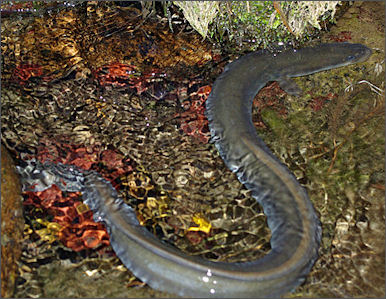 Eels are a long, thin slimy fish that have a fin that runs the entire lengths of the backs of their bodies, extends around the tail and run for a distance on the underside of the fish. They have a wide and strong mouth. [Source: Bruce Watson, Smithsonian]
Eels are a long, thin slimy fish that have a fin that runs the entire lengths of the backs of their bodies, extends around the tail and run for a distance on the underside of the fish. They have a wide and strong mouth. [Source: Bruce Watson, Smithsonian]
Eels are a popular food fish in Japan and Britain and other places. They have flaky, moist, and white flesh. Conger eels can be two to two and half meters (seven to eight feet) in length and 25 centimeters (10 inches) in diameter. They are nocturnal bottom feeders. The ones that people eat in Japan can reach lengths of one and half meters (five feet).
James Prosek wrote in National Geographic, “Freshwater eels, of the genus Anguilla, are ancient fishes. They began evolving more than 50 million years ago, branching into 18 species and three subspecies. Most migratory fish, such as salmon and shad, are anadromous, spawning in fresh water and living as adults in salt water. The freshwater eel is one of the few fishes that do the opposite, spawning in the ocean and spending their adulthood in lakes, rivers, and estuaries — a life history known as catadromy. In general, female eels are found upstream in river systems, while males stay in the estuaries. Eels may spend decades in rivers before returning to the ocean to spawn, after which they die. No one has ever been able to witness freshwater eels spawning, and for eel biologists, solving this eel-reproduction mystery remains a kind of holy grail. [Source: James Prosek, National Geographic, September 2010]
Websites and Resources: Animal Diversity Web (ADW) animaldiversity.org; National Oceanic and Atmospheric Administration (NOAA) noaa.gov; Fishbase fishbase.se ; Encyclopedia of Life eol.org ; Smithsonian Oceans Portal ocean.si.edu/ocean-life-ecosystems
Eel Characteristics
Eel scales are so smooth that eels seem scaleless. The same mucus that makes eels so slimy allows the live out of water longer than other fish. Eels can even bury themselves in mud and survive droughts. Some eels hibernate in the mud during the winter. Eels eat small fish, crustaceans and plankton. They usually swallow their prey whole but sometimes tear it to pieces. The top speed of an eel is about 10 miles per hour.
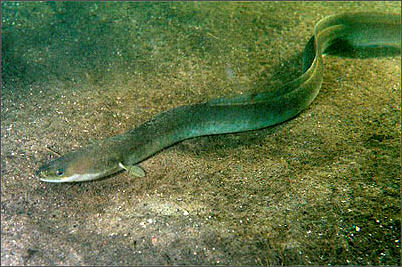 Eels range in length from five centimeters (2 inches) for the one-jawed eel to 4 meters (13 feet) for the slender giant moray. The heaviest true eel is the European conger, which can weigh up to 110 kilograms (240 pounds). Eeels possess no pelvic fins, and many species also lack pectoral fins. The dorsal and anal fins are fused with the caudal fin, forming a single ribbon running along much of the length of the animal. Eels swim by generating waves that travel the length of their bodies. They can swim backward by reversing the direction of the wave. [Source: Wikipedia]
Eels range in length from five centimeters (2 inches) for the one-jawed eel to 4 meters (13 feet) for the slender giant moray. The heaviest true eel is the European conger, which can weigh up to 110 kilograms (240 pounds). Eeels possess no pelvic fins, and many species also lack pectoral fins. The dorsal and anal fins are fused with the caudal fin, forming a single ribbon running along much of the length of the animal. Eels swim by generating waves that travel the length of their bodies. They can swim backward by reversing the direction of the wave. [Source: Wikipedia]
Most eels live in the shallow waters of the ocean and burrow into sand, mud, or amongst rocks. Most eel species are nocturnal, and thus are rarely seen. Sometimes, they are seen living together in holes or "eel pits." Some eels also live in deeper water on the continental shelves and over the slopes deep as 4,000 meters (13,000 feet). Only members of the Anguilla regularly inhabit fresh water, but they, too, return to the sea to breed.
The Anguillidae are a family of ray-finned fish that contains the freshwater eels. Eighteen of the 19 extant species and six subspecies in this family are in the genus Anguilla. They are catadromous fish, spending their adult lives in freshwater, but migrating to the ocean to spawn. The Japanese and American eels that people eat are in the Anguilla genus.
Eel Reproduction and Development
No one has ever seen eels mate or lay eggs. Aristotle cut open an eel and reasoned that since he found no eggs or ovaries "eels are derived from the so called 'earth guts' that grow spontaneously in mud and in humid ground." After eels spawn they die.
American eels spend most of their lives in rivers and estuaries but travel to the Sargasso Sea near Bermuda to spawn. “If you drained all the water out of the Atlantic and kicked a beach ball, it would roll to the Sargasso — it’s a deep hole,” “ Eel buyer Bill Sheldon told National Geographic. “There’s something inside these eels that makes them go deeper and deeper until they all wind up there to spawn.” After they spawn, the adults die. No one has ever witnessed eels spawning.
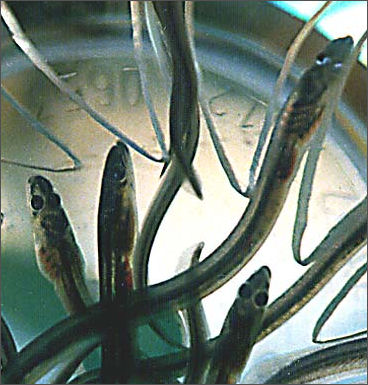
In the Pacific, eels appear to spawn near the Marianas Trench, the deepest part of the sea. In February 2011, scientists at the University of Tokyo said the figured out the secret of eels spawning in the Pacific. The scientists collected eggs released shortly before the new moon in West Mariana Ridge area of the Pacific. Based on their size the scientists determined the eggs were probably fertilized about 30 hours earlier.
Eel Migrations
Eels migrate in the reverse direction of salmon. They hatch and spawn in the sea and live most of their lives in rivers and lakes. Before they head back to the sea their eyes gets bigger so they can see better in the deep water where they spawn.
Young eels are transparent until they reach fresh water. Those that survive the first months of life drift with the currents until the reach coastal waters and are transformed into glass eels. When they start swimming up rivers they turn gray and brown and black.
In February 2011, scientists at the University of Tokyo said the figured out the secret of eels spawning in the Pacific. The scientists collected eggs released shortly before the new moon in West Mariana Ridge area of the Pacific. Based on their size the scientists determined the eggs were probably fertilized about 30 hours earlier.
Atlantic Eel Migrations
James Prosek wrote in National Geographic, “In biology class we were told that the eels we caught in creeks and ponds had emerged from eggs suspended in the ocean, specifically the Sargasso Sea, the southwestern part of the clockwise gyre in the North Atlantic — an idea that required more faith than imagination. We know that freshwater eels reproduce in the ocean because larvae have been found drifting near the surface thousands of miles from any shore. Eel larvae — tiny, transparent creatures with thin heads, bodies shaped like willow leaves, and outward pointing teeth — were thought to be a separate species of fish until 1896, when two Italian biologists watched one in a tank metamorphose into an eel. [Source: James Prosek, National Geographic, September 2010]
Eels are relentless in their effort to return to their oceanic womb. I can tell you this from personal experience because I've tried to keep them in a home aquarium. The morning after the first night of my attempt, I found eels slithering around the floor of my kitchen and living room. After securing a metal screen over the tank with heavy stones, I was able to contain them, but soon they were rubbing themselves raw against the screen. Then one died trying to escape via the filter outflow. When I screened the outflow, eels banged their heads against the glass until they had what appeared to be seizures and died. That's when I stopped trying to keep eels.

Atlantic eels, lifecycle and migrations, from William and Mary College
They're wondrous in their ability to move. They show up in lakes and ponds and postholes with no visible connection to the sea, leaving the inquisitive shaking their heads. On wet nights eels have been known to cross land from a pond to a river by the thousands, using each other's moist bodies as a bridge. Young eels have been seen climbing moss-covered vertical walls. In New Zealand it's common for cats to bring eels to the doorsteps of farmhouses, having caught them in grassy paddocks.
"How many animals are there that live in such diverse habitats?" David Doubilet mused while photographing eels in New Zealand, knee-deep in a spring-fed creek, watercress dangling from his mask and snorkel. "Here we have a fish that is born in the deepest, darkest depths of the ocean, and yet here you have them in a farm paddock with cows."
Eels as Food
Eels are popular food in Britain, Japan, and other places. In Japan they are slathered in barbecue sauce and smoked or served as sushi. In Britain, the are made into pies offered at pubs or made into jellied eels,. Wild eels are caught in bated traps. Most eels are raised on farms.
People in Japan have eaten eel for thousands of years. Japanese eel (Anguilla japonica) can be found across East Asia. Eels are eaten year-round, but consumption peaks in the summer. The fish are a big part of some local economies. [Source: Clancy Morgan, Business Insider, May 22, 2021]
About 100,000 tons of eels is consumed in Japan each year. At one time this was about 70 percent of the worldwide eel production. The global catch of Japanese eel has declined by more than 75 percent since 1980. In Japan, this has coincided with an increase in demand. In 2014, Japanese eels were classified as endangered, and because of low domestic catch. The majority of eels eaten in Japan are imported from China and Taiwan. If prices are too high, restaurants struggle to make a profit.
Eel is supposed to be an aphrodisiac. It is supposed to be especially portent if served with a phallic shaped plum. Lake Hamana, near Nagoya, is famous for eel production. Towns around the lake sell eel pie made with powdered dried eels and garlic. Eels are a popular food in Britain, where they are made into pies served at pubs.
Unagi

unagi in Japan One of the most poplar summer dishes in Japan is unagi (barbecued sea eel) served over steaming rice or as sushi with a delicious sweet brown sauce. "Grilled eel" wrote Reid, "has long been considered a luxury meal in Japan. It has a consistency similar to fried fish and tastes something like barbecued chicken. Unagi is believed to be ward off the summer heat. It is commonly eat en masse on July 25, mid-summer according to the traditional Japanese calendar.
"The idea of eating unagi as way to cool off was a promotional gimmick dreamed up by the national association of unagi restaurants," Reid wrote. "The marketing strategy has worked. On hot summer days people wait in long lines to get inside unagi restaurants and the biggest eel-eating day of the year...It hardly seems like a way to beat the heat, but the eel industry here has successfully sold the serpentine specimen as a high-protein meal that provides stamina in muggy weather." When Reid asked one salaryman why he was eating eel, he answered, 'I need strength to deal with this oppressive heat. Everybody knows that eel makes you strong in summer."
Unagi that are sold in supermarkets are about 30 centimeters (a foot long). They are split down the back, gutted, deboned, butterflied, cut into square fillets, skewered, dipped in a sweet soy sauce, and grilled. Then they’re vacuum- packed, ready to be exported or sold locally. [Source: National Geographic]
Eel Restaurants in Japan
The strong yen in the 1980s brought in imported eels — from Taiwan, Thailand and South America — and prompted the development of countless 'budget' eel restaurants. These places tend to be built around a barbecue pit, where ‘sweating cooks stand in clouds of smoke plopping slimy eels onto the glowing grill. [Source: T.R. Reid, the Washington Post]
Popular unagi restaurants can sell 40 to 50 tons of eel each year. Surugaya is one of the most famous unagi restaurants. It has been serving eel for over 150 years. The final dish is called kabayaki. It is served in a lacquer box with rice is called unajū. It can cost up to $91 depending on the price of adult eel. That high demand such dishes is part of the reason young eels are so expensive. Kabayaki looka simple, but preparing it right takes years to master.
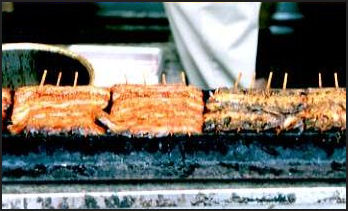
grilling unagi Workers prepare eel alive to maintain. Doing so ensures that it is fresh. But handling slippery, slimy eels is ifficult. Remove the bones and cutting the eels to the proper size for the skewers while the fish is still wriggling is a challenge. Unagi chef Rui Kinoshita told Business Insider: "There is a saying about cooking eel. It takes three years to master the skewering. Slicing takes eight years. Grilling needs a whole life to master."
Preparation of Eel in Japan
Eels are prepared two ways: Tokyo style in which eels are broiled or grilled over charcoal and Osaka style in which the eels are steamed. Some places combine the two methods, dipping the eels in the sauce several times during the preparation process.
The best unagi restaurants like Surugaya steam, then grill each eel three times, dipping it into sauce between each grilling. The eel has to be constantly monitored while it's cooking to achieve even grilling. Unagi chef Rui Kinoshita told Business Insider;The best eels for us have good texture. Not too hard, not too soft. Presentation and taste have to be equally good. When you open the lid, it has to look beautiful. [Source: Clancy Morgan, Business Insider, May 22, 2021]
Fatty eels were blamed for the burning down of a popular restaurant in Tokyo in the 1990s. Fat dripping from grilled eels caught fire, causing the eels on an automated gas roasting rack to catch fire, with the fire spreading through the air duct of the exhaust system to the rest of the restaurant.
Gourmet Eels in Japan
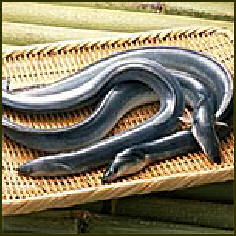 The tastiest eel is said to be wild eels, especially those caught in the Tonegawa River north of Tokyo. Of the 100,000 tons of eels consumed each year only 300 tons are wild ones, and of these only 50 tons come from the Tonegawa River, about 0.05 percent of all the eel consumed. Usually the only place you can find these eels is in high-end Tokyo restaurants.
The tastiest eel is said to be wild eels, especially those caught in the Tonegawa River north of Tokyo. Of the 100,000 tons of eels consumed each year only 300 tons are wild ones, and of these only 50 tons come from the Tonegawa River, about 0.05 percent of all the eel consumed. Usually the only place you can find these eels is in high-end Tokyo restaurants.
Eels in the Tonegawa River feed on freshwater prawns, crabs and minnows. The time of the year ro catch them is between September and November, when they head down the river to the east to spawn and are fattened up from a summer of feeding.
The Tabeta restaurant in Tonoshomachi, Chiba Prefecture, 30 kilometers from the mouth of the Tonegawa River, specializes in eels caught in the river by 20 local fishermen. Before they are served up the eels are kept in a fish tank into which groundwater is pumped, allowing the eels it spit up mud they have ingested with food such as crabs and replace it clean water. When ready the eel is cut open and the fillet is skewered on a bamboo stick and grilled, so that dripping fat causes flames to flare, and then steamed, with the whole cooking process taking about 30minutes. After that the eels are repeatedly basted with sweet sauce and flipped over a fire.
A cook at Tabeta told the Daily Yomiuri, “Every time I flip it, water and fat inside the thick fillet permeate the core of the fillet, helping it cook as it if it were being roasted in a covered pan.” The process softens the fillet and small bones, So people don’t mind eating the bones.” When Daily Yomiuri photographer Tasushi Wada ate some he said, “It is very soft and had no trace of a bad mud smell. With each bite of the thick fillet, my mouth was filled with juicy flavor.”
Low Eel Catches in Japan
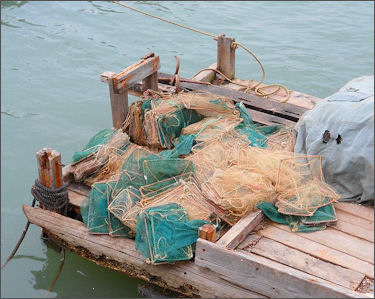
Eel nets in Haikou, Japan Suvendrini Kakuchi wrote in the Los Angeles Times, “Dramatically lower eel catches from local river habitats have led to an overwhelming dependency on expensive fish farms and imports, forcing restaurants like Takayasu's out of business.” In 2009, “eelers caught 267 tons from natural habitats, a drop of two-thirds from the amount caught a decade earlier, according to the Nihon Yoshoku Shinbun, a publication that tracks marine resources. Last year's catch was less than 1 percent of the nearly 35,000 tons consumed; farming provided nearly 11,000 tons, and imports from China and Taiwan accounted for the remainder, the publication said.” [Source: Suvendrini Kakuchi, Los Angeles Times, September 04, 2010]
Industry experts have criticized the quality of imports as uneven and have noted that cultivating eels on about 300 fish farms nationwide is a high-risk, labor-intensive venture."The sad story of Japanese unagi is just one of the many examples of how Japan's voracious appetite for fish has created problems for itself," said Hiroyuki Matsuda, eel resource researcher at Yokohama National University.
Michimasu Takayasu, fifth-generation restaurant owner, told the Los Angeles Times he worries about the growing expense. His Chuhei Co. is famous for the Bando taro variety of eel, a local species savored for its succulent meat but no longer found in local rivers. The eels are cultivated on expensive natural fish feed at two breeding farms in Japan, and annual harvests amounting to about 60 tons are sold to top restaurants in Tokyo. "Very soon, eating at special eel restaurants like ours might be only for the very rich," Takayasu said. "That's not going to do us any good."
High Prices for Eels in Japan
Unagi can cost more than bluefin tuna. Overfishing has led to a decline in eel populations. The global catch of Japanese eel declined by more than 75 percent since 1980, contributing to high prices. In January 2018, young eels, also called glass eels, cost around $35,000 per kilogram. [Source: Alexandra Appolonia, Business Insider, November 3, 2022; Clancy Morgan, Business Insider, May 22, 2021]

Eel nets in Haikou, Japan
Prices for young eels can vary widely year to year. Eel farmer Kouji Yamamoto told Business Insider: When they can't catch enough young eel, the price goes up. When the price is so high, what can those farmers do? Finding the right balance is currently the biggest problem.
Unagi chef Rui Kinoshita told Business Insider: What is happening these days is the difference in the price is so much each year. It can be tripled compared to last year. Next year can be a third of the year before. The amount of eel catch is a matter of life and death for eel restaurants. We all are very concerned about it. I myself am concerned too.
here have been efforts to increase eel populations such as regulating fishing, releasing adult eels back into the water, and researching how to hatch eels in farms. Many people skirt the rules and norms and even organized crime has become involved in eel trade.
Image Sources: Wikimedia Commons, National Oceanic and Atmospheric Administration (NOAA); JNTO, Japan Zone Andrew Gray Photosensibility, Hector Garcia,
Text Sources: New York Times, Washington Post, Los Angeles Times, Times of London, Yomiuri Shimbun, The Guardian, National Geographic, The New Yorker, Time, Newsweek, Reuters, AP, Lonely Planet Guides, Compton’s Encyclopedia and various books and other publications.
Last updated April 2023
